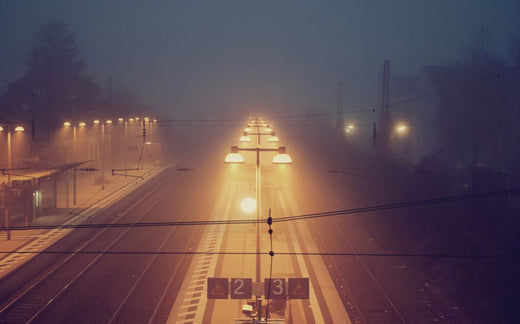What’s in the Fog?

Mystery and fear has always surrounded fog, and for good reason: low visibility. Ships and cars can easily collide in the fog without heightened caution. Once upon a time (1980, to be exact), there was even a horror film made about supernatural evil that arrived in fog. Usually, the fog was only obscuring the danger. What if–the fog itself is the danger?
In its pure form, fog is simply the presence of tiny droplets of water vapor that hang in the air. Normally, you can’t see water vapor. However, if cool air comes close to the surface of warm earth or water, it can’t condense into the form of rain or dew, because the warmth prevents it from condensing. There are several interesting types of fogs, including radiation fog, advection fog, evaporation fog and hail fog. (How Fog Forms) Radiation fog has nothing to do with nuclear activity; it refers to the way heat is released from the earth at night through the atmosphere. The surface of the earth cools, but if there is a lower layer of warm, moist air, the humidity of that air goes to 100% and causes small water droplets to hang in the air, until the sun comes up and evaporates them. This is why you can get very wet just by walking through fog!
Fog naturally occurs in many parts of the world in the winter, especially in valleys, because air that cools in the mountaintops becomes dense and moves down into the valleys at night, where it cools the air that is in the valley, forming fog. Limited visibility is the main problem when there’s not substantial air pollution. With air pollution, however, the fog also creates hazardous breathing conditions for anyone in the area, because the water vapor not only traps chemical impurities. Here’s the difference between fog and smog: fog (pure water droplets) is a natural occurrence, but smog is the combination of smoke and fog. Smog is very bad for breathing.
Here are just a few of the smog-related illness headlines: “Thick fog heightens risk of diseases”, “Pneumonia outbreak kills over 240 children in Pakistan's Punjab in January”, January 2024, Islamabad: Cities in Pakistan like Islamabad and Lahore struggle with bad air quality. The smog in Lahore in November 2024 was even visible from space. The country has a myriad of pollution sources including dusty roads, brick kilns and other industry, low-quality vehicle fuel, and agricultural burning. Doctors and medics know that the smog is deadly to children and the elderly because it causes pneumonia–but how, exactly, does a chemical smog cause pneumonia, which usually comes from bacteria, viruses, or fungi? (Pneumonia Causes and Risk Factors)
Now, scientists are realizing that chemicals and smoke are not the only problem in smog. Fog and, by extension, smog, has the potential to both transport and maintain pathogen (bacteria, fungus, virus) viability. In 2018, scientists studied bacteria populations that changed and increased in fog as it formed in two different areas: Coastal Maine and the Namib Desert in Namibia, southwestern Africa. The fog carried marine bacteria as far as 50 km inland. (The biology of fog: results from coastal Maine and Namib Desert reveal common drivers of fog microbial composition)
In February 2024, researchers sampled air in a rural area of India and discovered that a 40–60% increase in the abundance of pathogenic bacteria for respiratory and skin diseases is noticed in fog period. Among the fog-enriched bacteria, Cutibacterium, Herbaspirillum, Paenibacillus, and Tsukamurella are examples of opportunistic bacteria causing various respiratory diseases, while Paenibacillus can even cause skin cancer and acute lymphoblastic leukemia.. (Fog caused distinct diversity of airborne bacterial communities enriched with pathogens over central Indo-Gangetic plain in India)
The problems in Pakistan and India air quality are not new–basically the same factors contributed to the Great Smog of London in 1952. A cold weather snap before the event caused Londoners to burn a lot of coal to stay warm, but the coal was also of poor quality with a lot of sulfur in it due to postwar shortages. The city had also recently converted from electric trams to diesel buses, which contributed to air pollution along with industrial sources. London then had a temperature inversion, in which a warmer layer of air above a cooler layer of air, restricting air movement and causing pollutants to be trapped near the earth’s surface (for more information on inversions check out our article). This 5-day event killed 4000-6000 people in the first few weeks and elevated mortality for months after, even up to 12,000 according to research from 2004.. Most of the deaths were caused by respiratory tract infections, from hypoxia and as a result of mechanical obstruction of the air passages by pus arising from lung infections caused by the smog. (Great Smog of London) The scientists did not sample bacteria in the air during this time, however, it’s reasonable to theorize that the horrible amount of sulfur dioxide and particulates in the air probably caused major respiratory irritation, which then gave advantage to any kind of pathogenic bacteria; it’s also reasonable to assume that levels of pathogenic bacteria were elevated in the fog.
This brings us to recent reports that fog in certain parts of the US and the UK is causing illness. “Fogvid 24” has alien and government conspiracy origin theories, because it’s left many feeling sick in both countries with flu-like symptoms after exposure, and it’s disrupted many flights in the UK. There’s been no official tests on these fogs, but here’s what I know: airports are near cities. Cities tend to have smog events, especially during winter temperature inversions. Smog can cause flight cancellations. Smog events are also known to cause illness. Here’s a video that I think makes a lot of sense. The “particles” she’s talking about at the end are not only pollution particulates, they are also MICROBES, which do make people sick. Our advice: if the weather forecast includes “fog”, to be on the safe side, treat it like “smog”, especially if your prevailing winds come from the direction of a major city or industrial area! These precautions include:
- Wear an N-95 or equivalent mask when you go outside
- Run air purifier(s) with HEPA filter in the places you spend the most time: your kitchen, home or office, and bedroom.
- Remove outer clothing when you come in the house and be sure to shower/bathe at night before going to bed, including your hair
- Help children, the elderly and those with compromised immune systems to stay indoors if possible.
- Change your HVAC system filters more frequently
- Use purifiers with ionizers such as the Mold Guard, Air Angel and Whole Home Unit, to kill germs in the air and on surfaces.
Be safe in the fog, friends!
Photo by Robin Röcker on Unsplash






